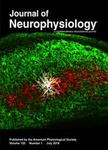版权所有:内蒙古大学图书馆 技术提供:维普资讯• 智图
内蒙古自治区呼和浩特市赛罕区大学西街235号 邮编: 010021

作者机构:Univ Calif Los Angeles Dept Physiol Sci Los Angeles CA 90095 USA Univ Calif Los Angeles Brain Res Inst Los Angeles CA 90095 USA Natl Inst Fitness & Sports Dept Physiol Sci Kagoshima 89123 Japan
出 版 物:《JOURNAL OF NEUROPHYSIOLOGY》 (神经生理学杂志)
年 卷 期:1999年第82卷第1期
页 面:359-369页
核心收录:
学科分类:0710[理学-生物学] 1001[医学-基础医学(可授医学、理学学位)] 07[理学] 071003[理学-生理学]
基 金:NINDS NIH HHS [NS-16333] Funding Source: Medline
主 题:肌电描记术 后肢/神经支配 后肢/生理学 行走/药物作用 行走/生理学 运动活动/药物作用 运动活动/生理学 肌 骨骼/神经支配 肌 骨骼/生理学 体位 脊髓/生理学 士的宁/药理学 录像 动物 猫 女(雌)性
摘 要:Adult spinal cats were trained initially to perform either bipedal hindlimb locomotion on a treadmill or full-weight-bearing hindlimb standing. After 12 wk of training, stepping ability was tested before and after the administration (intraperitoneal) of the glycinergic receptor antagonist, strychnine. Spinal cats that were trained to stand after spinalization had poor locomotor ability as reported previously, but strychnine administration induced full-weight-bearing: stepping in their hindlimbs within 30-45 min. in the cats that were trained to step after spinalization, full-weightbearing stepping occurred and was unaffected by strychnine. Each cat then was retrained to perform the other task;for 12 wk and locomotor ability was retested. The spinal cats that were trained initially to stand recovered the ability to step after they received 12 wk of treadmill training and strychnine was no longer effective in facilitating their locomotion. Locomotor ability declined in the spinal cats that were retrained to stand and strychnine restored the ability to step to the levels that were acquired after the step-training period. Based on analyses of hindlimb muscle electromyographic activity patterns and kinematic characteristics, strychnine improved the consistency of the stepping and enhanced the execution of hindlimb flexion during full-weight-hearing step cycles in the spinal cats when they were trained to stand but not when they were trained to step. The present findings provide evidence that 1) the neural circuits that generate full-weight-bearing hindlimb stepping are present in the spinal cord of chronic spinal cats that can and cannot step;however, the ability of these circuits to interpret sensory input to drive stepping is mediated at least in part by glycinergic inhibition;and 2) these spinal circuits adapt to the specific motor task imposed, and that these adaptations may include modifications in the glycinergic pathways that provide inhibition.